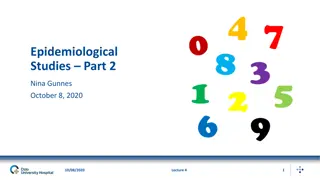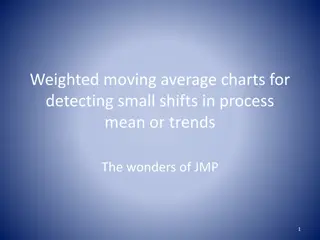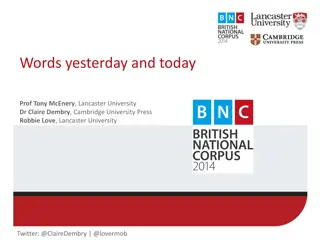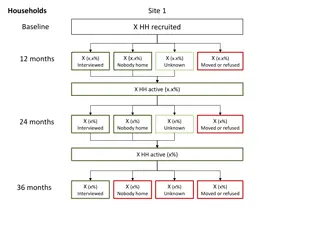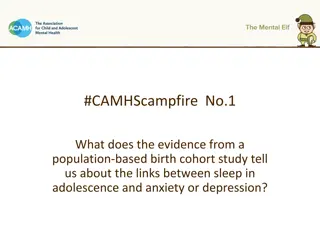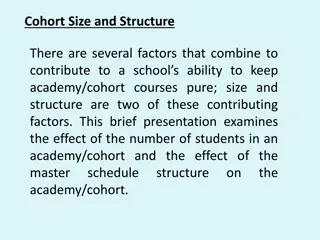Understanding Moving Patterns of Over-75s in Cambridge City Cohort - Insights from CC75C Study
"Exploring the impacts of delayed moving decisions among older individuals aged 95 and above in the Cambridge City over-75s cohort (CC75C). The study reveals demographic attributes, triggers for moving, and patterns of relocation, shedding light on the challenges faced by this age group in terms of housing, health, and social care."
Download Presentation

Please find below an Image/Link to download the presentation.
The content on the website is provided AS IS for your information and personal use only. It may not be sold, licensed, or shared on other websites without obtaining consent from the author. Download presentation by click this link. If you encounter any issues during the download, it is possible that the publisher has removed the file from their server.
E N D
Presentation Transcript
Cambridge City over-75s Cohort (CC75C) Fiona Scheibl 1 University of Cambridge
Context Increasing numbers of older people either choose or are compelled to move in later life : those living with dementia, frailty, inadequate care provision. Shortfall of age appropriate housing : many older people live in homes with health hazards (falls, heating, damp).
Context Policy of ageing in place and shortfall of age appropriate housing means most older people live in main housing stock. Many live alone - and this trend is projected to increase by between 53,000 and 155,000 per year. Nearly half (47%) of those aged 75-84 and 61% of those aged 85 or older were lone households. also low income. Only 9% of older households had moved in the past three years compared to 36% of younger households. Those who do move cite family or personal reasons or desire for a smaller home.
What happens when older people delay moving till 95+? Use data from Cambridge City over-75s Cohort (CC75C). Began in 1985 and targeted all men and women aged 75 or older registered with geographically and socially representative general practices in Cambridge. 95% response rate only cause of attrition was death. 2166 individuals form the baseline sample for the longitudinal cohort. Data collection every 3-4 years. An extensive resource of qualitative and quantitative data from a representative sample of very old people and their relatives.
Who moved? Who moved? Year 21 survey included 44 of 48 surviving participants (91%). 18 (41%) were still living in their own homes 26 (59%) had moved Most moves 18 (41%) were into a care home Three moved in with family. Five moved into sheltered housing. One was in hospital. Of those who had already moved eight (29%) later moved again.
Demographic attributes of movers All aged 95+, 1 male, 25 females. 55% were manual workers, 45% white collar workers, 23 widows, 2 single, 1 divorced. 22 disabled, 2 not disabled, 2 only IADL disability. The majority (n=22) were assessed as having some level of cognitive impairment. 11 were identified as having severe impairment. 9 had moderate impairment. 2 had mild cognitive impairment. 4 were cognitively intact.
Triggers for moving Triggers for moving 1) Reactive : Majority (20) people moved into residential care after a health or social care crisis: a fall and hospitalisation was a key trigger also bereavement and risk due to increased cognitive impairment 2) Proactive: two people made a planned move either in with family or to a smaller house 3) Complex: four people moved in situations where they experienced a crisis such as bereavement and then decided to move closer to family or move in with family This finding is consistent with US studies. G Pope, N., D, and B. Kang (2010). "Residential Relocation in Later Life : A Comparison of Proactive and Reactive Moves." Journal of Housing for the Elderly 242: 193-207.
PROCESSOFREACTIVEMOVESINTOCAREHOME CARE AND HOUSING CONTEXT RISK OF MORAL PRESSURE AND IMPOSED DECISION MAKING UNABLE TO CLIMB STAIRS DISTANT FROM RELATIVES HOSPITALISED AT RISK OF SELF NEGLECT MOVES INTO CARE HOME LACK OF INFORMAL CARE RESPITE CARE LACK OF SUPPORT FROM FORMAL CARE SERVICES CONNECTIONS MAKE TRANSITION EASIER TRAUMA AND DISTRESS FOR RELATIVES FALLS FRAILTY COGNITIVE DECLINE BEREAVEMENT
PROCESSOFPROACTIVEANDCOMPLEXMOVES OLDER PEOPLE HAVE GREATER OWNERSHIP OF DECISION MAKING CARE AND HOUSING CONTEXT UNABLE TO CLIMB STAIRS SECOND MOVE OUT OF FAMILY HOME / SHELTERED HOME INTO CARE HOME MOVES WITH FAMILY MOVES INTO SHELTERED HOUSING MOVES INTO CARE HOME TO BE CLOSER TO FAMILY HOUSE / GARDEN TO BIG DISTANT FROM RELATIVES LACK OF FORMAL CARE SERVICES CONNECTIONS EASE TRANSITION INTO CARE ISOLATION LONELINESS FAILING HEALTH BEREAVEMENTE TRAUMA AND DISTRESS FOR RELATIVES
How was decision to move made? How was decision to move made? Figure 1: Ownership of decision making in reactive, complex and proactive moves High Ownership Shared ownership Contested No ownership Self-Motivated Agreed Negotiated Protracted Dependent Imposed Proactive moves where older person plans ahead Complex and Reactive moves in with family or into care. Reactive moves into care where family suggest the move, the older person is initially hesitant but comes to see a benefit for all family not just themselves Reactive moves into care involving resistance on the part of the older person and moral pressure from family or neighbours who invoke Social Services or a psychiatric geriatrician to make a formal referral into care Reactive moves into care where older person lacks capacity to make decision Reactive moves into care where family makes the decision without consulting older person
Figure 2 Eight experiences associated with moving in very old age Reactive and Complex moves into care Proactive moves into sheltered housing Complex moves in with family Increased isolation No regrets Gratitude and appreciation Regret and loss Dissatisfaction and resentment Acceptance and resignation Reduced loneliness for older old across all moves Trauma and distress for relatives across all moves
Relatives experiences of oldest old moving The dominant experience for relatives was one of trauma and distress: This was true across all types of moves Into care Into a smaller home In with family
Moving is difficult but necessary Moving is difficult but necessary Edith Perkins (100, severe cognitive impairment, disabled) Well, it was a very difficult situation really, because I didn t want to give up my independence, which to a certain extent you ve got to. But you ve got to think about it in the right sort of way. Because if I was to go on like that, there might be a time when it would cause trouble. And that wouldn t be very nice for a start. So that s the way I look at it.
Connections as a facilitator to moving Moving locally or having respite care allowed older person to maintain existing connections and make new relationships in the care home prior to permanent move Glynnis Gough (moved in to sheltered housing in local area): But when I came here (to sheltered housing) I knew quite a few people. One, for the fact that I used to live across the road years ago I knew people from then. And I used to work at the post office up here. I worked there for 14 years and I knew a lot of people here knew me . Daughter of Edith Perkins (who moved into care home she had respite stays with): She settled in quite well. Yes. Oh yes, no problems at all. (She had been in respite at the home, so) At least she knew where she was going and she knew a lot of the people, the staff.
Key observations Connections to place and people act as a facilitator for moving (into care.) Older people were happier to move to a care home or sheltered housing where they had friends, knew staff or a relative worked there. Older people experienced regret and loss when they did not feel they owned the decision to move. In this study a move into care reduced isolation more often than it increased isolation. Having a serious fall late in life is closely associated with a move into care.
Reflections on the CC75C findings 1. Older people need support and the opportunity to move to age friendly housing prior to crisis. 2. Need to address shortfall of age friendly housing across a broad range from sheltered through to extra care e.g. the DWELL model in Sheffield. 3. Multigenerational homes where whole families with grandparents can live. 4. Integrate housing and care homes into local communities 5. Perhaps offer removal costs subsidies or a help to move workforce.









